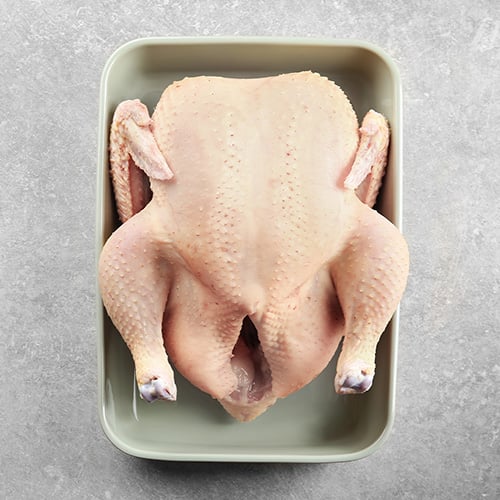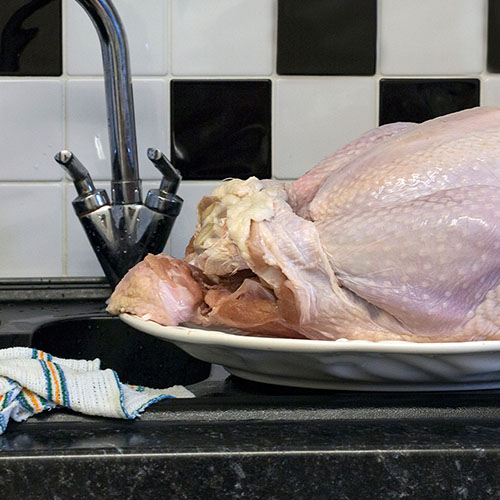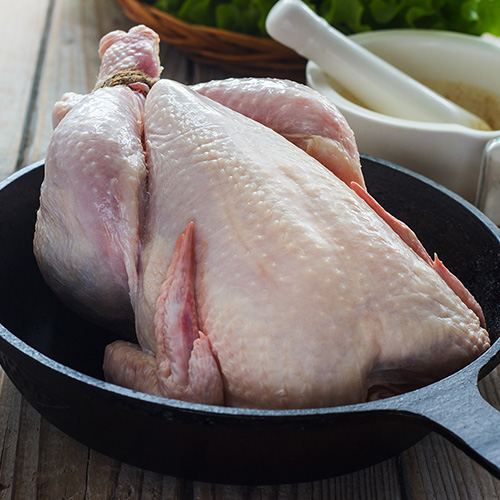How to Defrost a Turkey
While defrosting a turkey might not be the most exciting part of preparing a Thanksgiving feast, it is essential for cooking it the right way. Not only does defrosting a turkey help the meat to cook evenly, but it also reduces cook times. Additionally, cooking a turkey that isn't defrosted can result in unsafe meat and potentially lead to a foodborne illness outbreak. We'll walk you through the different ways to defrost a turkey and how long to defrost it below.
How to Defrost Turkey in a Refrigerator

This method allows for a slow and controlled thaw, ensuring that the turkey stays at a safe temperature throughout the process. Follow the steps outlined below to thaw a turkey in the refrigerator.
- Keep the turkey in its original packaging: Packaging prevents cross-contamination in the refrigerator. Do not remove the wrapping from the turkey until thawed for the best results.
- Place the turkey in a pan: Place the turkey breast side up on a tray or in a shallow pan to catch any liquid that drips from the turkey as it thaws. The tray or pan should be large enough to accommodate the turkey and prevent turkey juices from spilling onto other foods in your fridge.
- Place the pan in the refrigerator: Clear an area in your refrigerator to store the turkey as it thaws. Verify that the refrigerator is set to 40 degrees Fahrenheit or below to ensure it remains at a safe temperature during thawing.
- Allow the turkey to thaw: As a general rule of thumb, allow at least one day of thawing for every 5 pounds of meat.
- Monitor the turkey: During the thawing process, keep an eye on the turkey and check for any signs of spoilage. A thawed turkey should still have a slight chill to the touch and not feel slimy or have a strong odor. If you notice these signs, discard the turkey immediately and do not consume it.
How to Defrost Turkey in Cold Water

Thawing a turkey in cold water takes less time than thawing it in a refrigerator but requires more attention. Continue reading to learn how to thaw a turkey in cold water the right way.
- Keep the turkey in its original packaging: Just as you would when thawing in the refrigerator, keep the turkey in its original wrapping to prevent contamination and contain its juices.
- Place the turkey in a container: Place the turkey breast side down in a container large enough to hold it. Make sure the container is clean and sanitized to maintain food safety.
- Fill the container with water: Fill the container with enough cold water to completely cover the turkey. Cold water helps keep the turkey at a safe temperature while it thaws.
- Change the water: Empty the container and fill it with new water every 30 minutes to maintain water temperature and prevent bacterial growth.
- Allow the turkey to sit: You can expect approximately 30 minutes of thawing time for each pound of turkey.
- (Optional) Flip the turkey: If you cannot completely submerge the turkey in water, you can still thaw it in cold water by rotating it every 30 minutes. Doing so ensures even thawing, helping the turkey to defrost properly.
How Not to Defrost a Turkey
When preparing turkey, it's essential to understand what defrosting methods to avoid and why you should avoid them. For the best results, steer clear of the methods listed below.
Avoid Thawing Turkey at Room Temperature
Defrosting a turkey at room temperature puts it in the temperature danger zone, which is between 40 and 140 degrees Fahrenheit. This temperature range is the perfect breeding ground for bacteria to grow and cause foodborne illness if consumed. Another risk of defrosting a turkey at room temperature is the potential for cross-contamination. As the turkey thaws, any juices that may leak out can easily come into contact with other foods or surfaces in your kitchen, spreading harmful bacteria.
Avoid Thawing Turkey In the Microwave
While defrosting a turkey in the microwave is technically safe when done correctly, there are several drawbacks to consider. Not all microwaves are powerful enough or large enough to handle a whole turkey. Thawing a turkey in a small microwave can lead to uneven thawing and leave certain parts of the bird frozen. Uneven thawing can negatively affect the taste and texture of the meat, leaving you with a less-than-ideal turkey experience.
How Long Does It Take to Defrost a Turkey?

When defrosting a turkey, it’s important to plan ahead. The amount of time it takes to defrost a turkey depends on the thawing method you choose.
- Refrigerator: If you opt for refrigerator thawing, it's recommended that you allow one day for every 5 pounds of turkey. For example, if you have a 15-pound turkey, allow it 3 days to thaw in the refrigerator. This method ensures a safe and even thaw, as the turkey thaws at a consistent temperature.
- Cold water: When thawing a turkey in cold water, you’ll need to allow 30 minutes for each pound of meat. A 15-pound turkey would take around 7.5 hours to thaw in cold water. Cold water thawing can be a quicker alternative, but it requires a bit more hands-on attention.
How Long Can You Store a Fresh Turkey in the Fridge?
In general, you can store a raw turkey in the refrigerator for 1-2 days. However, the exact time that it can be stored depends on the size of the bird and when you started thawing it. For the best results, calculate how long it will take to thaw your turkey beforehand. If you have a large turkey that will take several days, make sure you give yourself plenty of time. Once your turkey is fully thawed, cook it as soon as possible. If you let your turkey sit for too long, bacteria may start to grow.
Back to TopDefrosting a turkey might sound like a simple task, but there are several methods you can use. However, not all methods are equally effective or safe. It's important to consider how much time you have, the size of your turkey, and how many people you'll be feeding as you choose a method. Whether your restaurant will be open on Thanksgiving or you're just looking to prepare turkey the right way, adhere to the information above for the best results.








